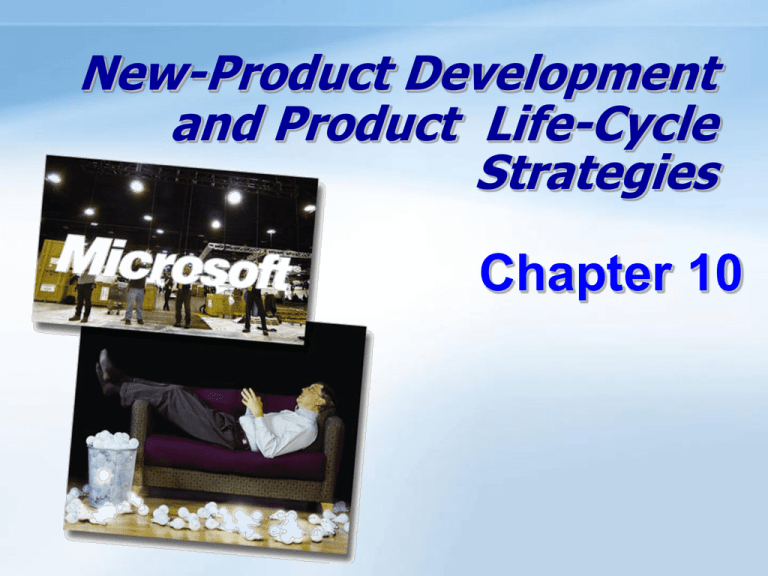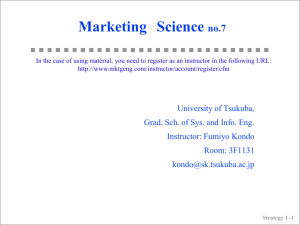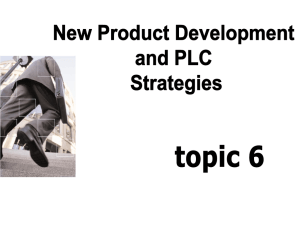Ch. 10
advertisement

New-Product Development and Product Life-Cycle Strategies Chapter 10 Objectives Understand how companies find and develop new-product ideas. Learn the steps in the new-product development process. Know the stages of the product life cycle. Understand how marketing strategies change during the product’s life cycle. 10- 1 Microsoft c $50 billion in profits over 27 years Early new product development relied heavily on copying the competition $4.2 billion annually invested in R & D Innovation is critical to Microsoft’s future success Much of R & D efforts are Internet related Many new products and services are in development 10- 2 Definition New Product Development Development of original products, product improvements, product modifications, and new brands through the firm’s own R & D efforts. 10- 3 New-Product Development Strategies Strategies for Obtaining New Product Ideas Acquired Companies Original Products Acquired Patents Product Improvements Acquired Licenses Product Modifications New Brands 10- 4 New Product Development Process Marketing Strategy Concept Development and Testing Idea Screening Idea Generation Business Analysis Product Development Test Marketing Commercialization 10- 5 New Product Development Strategy New Product Development Process: Stage 1: Idea Generation Internal idea sources: • R&D External idea sources: • Customers, competitors, distributors, suppliers 10- 6 3M’s corporate culture encourages, supports, and rewards new product ideas and innovation 10- 7 Using the Web to Solicit Product Ideas Procter and Gamble To see how P&G solicits ideas from customers, visit the Procter and Gamble home page, click on the Resources and Offers button, then select the Share Your Thoughts listing. Procter & Gamble 10- 8 New Product Development Process Step 2. Idea Screening Many companies have systems for rating and screening ideas which estimate: Process to spot good ideas and drop poor ones as soon as possible. Market Size Product Price Development Time & Costs Manufacturing Costs Rate of Return Then, the idea is evaluated against a set of general company criteria. 10- 9 New Product Development Process Step 3. Concept Development & Testing 1. Develop Product Ideas into Alternative Product Concepts 2. Concept Testing - Test the Product Concepts with Groups of Target Customers 3. Choose the Best One 10- 10 New Product Development Process Step 4. Marketing Strategy Development Marketing Strategy Statement Formulation Part One Describes Overall: Target Market Planned Product Positioning Sales & Profit Goals Market Share Part Two Describes Short-Term: Product’s Planned Price Distribution Marketing Budget Part Three Describes Long-Term: Sales & Profit Goals Marketing Mix Strategy 10- 11 New Product Development Process Step 5. Business Analysis Step 6. Product Development Business Analysis Review of Product Sales, Costs, and Profits Projections to See if They Meet Company Objectives If No, Eliminate Product Concept If Yes, Move to Product Development 10- 12 BusinessNow Sensable Video Clip Computer modeling is being used to aid in product design 10- 13 Daimler is currently road-testing its prototype NECAR 5 (New Electric Car) 10- 14 New Product Development Strategy IRI BehaviorScan provides an inmarket laboratory for testing new products and marketing programs IRI BehaviorScan 10- 15 New Product Development Process Step 7. Test Marketing Test Marketing is the Stage Where the Product and Marketing Program are Introduced into More Realistic Market Settings. Budget Levels Packaging Branding Pricing Product Elements that May be Test Marketed by a Company Positioning Advertising Distribution 10- 16 New Product Development Process Step 7. Test Marketing Standard Test Market Controlled Test Market Full marketing campaign in a small number of representative cities. A few stores that have agreed to carry new products for a fee. Simulated Test Market Test in a simulated shopping environment to a sample of consumers. 10- 17 Where is a good test market? I. Factors to consider - Size - Demographics - Isolation from other cities - Media availability and cost - Retailer support 2. Popular cities - Big cities: Detroit, St. Louis, Columbus, Philadelphia - Small cities: Nashville, Jacksonville, Toledo, Wilmington 10- 18 New Product Development Process Step 8. Commercialization Commercialization is the Introduction of the New Product into the Marketplace. When? Where? To Whom? How? 10- 19 LIFE IS SHORT AND THEN YOU INTRODUCE A NEW PRODUCT Product lifetimes are shrinking, as competitors pressure innovators by offering imitations of successful, high-margin products. Panasonic now replaces electronic consumer products on a 90-day cycle (with older models going to discounters) the big Japanese car makers are aiming to offer new models every two years. (from the New York Times) Speeding Up Development Step 2 Step 3 Step 4 Step 2 Step 1 Simultaneous Step 1 Sequential Step 3 Step 4 10- 21 Discussion Question Why do products fail? See if you can identify the fatal flaw in the brands below and at right. Ben-Gay Asprin Buttermilk Shampoo Fruit of the Loom Laundry Detergent 10- 22 Causes of New Product Failures Overestimation of Market Size Product Design Problems Insignificant difference Product Incorrectly Positioned, Priced or Advertised Costs of Product Development Competitive Actions No access to the market Bad timing To create successful new products, the company must understand it’s customers, markets and competitors develop products that deliver superior value to customers. 10- 23 Alternatives to Development: Acquire new Products Develop "me-too" products. Revive old products Product Life-Cycle Strategies The Typical Product Life Cycle (PLC) Has Five Stages Product Development, Introduction, Growth, Maturity, Decline Not all products follow this cycle: Fads Styles Fashions 10- 25 Figure 10-2: Sales and Profits Over A Product’s Life 10- 26 Product Life Cycle length style - comes, goes, comes back fashion - come, goes away slowly fad - comes and goes way quickly Figure 10-3: Styles, Fashions, and Fads 10- 28 Companies want their products to enjoy a long life cycle. Hershey’s actively promotes the fact that it has been “unchanged since 1899” 10- 29 Product Life-Cycle Strategies Additional marketing investments can move a product back into the growth stage, as in the case of Cracker Jack. 10- 30 Product Life-Cycle Strategies The product life cycle concept can be applied to a: Product class (soft drinks) Product form (diet colas) Brand (Diet Dr. Pepper) Using the PLC to forecast brand performance or to develop marketing strategies is problematic 10- 31 Problems Using the PLC The PLC Concept Can Help in Developing Good Marketing Strategies for Different Stages of the Product Life-Cycle, However Some Problems Can Arise: Trouble identifying Which Stage of the PLC the Product Is In Difficult to Forecast the Sales Level, the Length of Each Stage, and Shape of the PLC Strategy is Both a Cause and a Result of the Product’s Life Cycle 10- 32 Product Life-Cycle Strategies PLC Stages Product development Introduction Growth Maturity Decline Begins when the company develops a newproduct idea Sales are zero Investment costs are high Profits are negative 10- 33 Product Life-Cycle Strategies PLC Stages Product development Introduction Growth Maturity Decline Low sales High cost per customer acquired Negative profits Innovators are targeted Little competition 10- 34 Product Life-Cycle Strategies PLC Stages Product development Introduction Growth Maturity Decline Rapidly rising sales Average cost per customer Rising profits Early adopters are targeted Growing competition 10- 35 Product Life-Cycle Strategies PLC Stages Product development Introduction Growth Maturity Decline Sales peak Low cost per customer High profits Middle majority are targeted Competition begins to decline 10- 36 Product Life-Cycle Strategies PLC Stages Product development Introduction Growth Maturity Decline Declining sales Low cost per customer Declining profits Laggards are targeted Declining competition 10- 37








